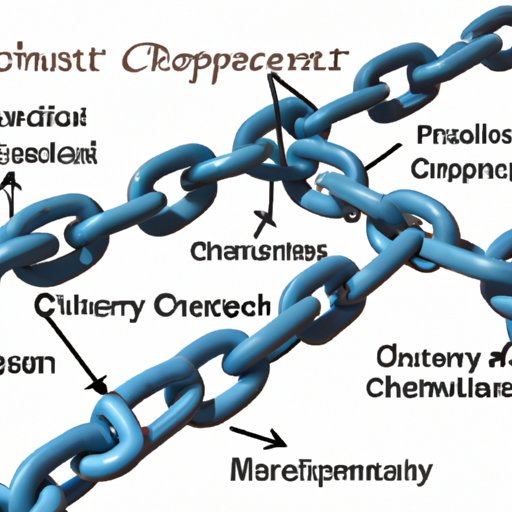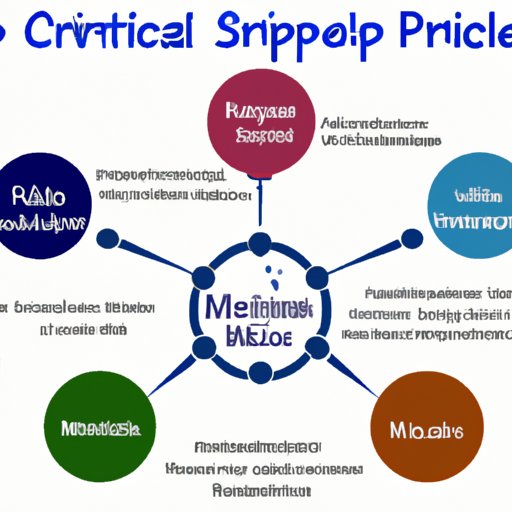Introduction
Integration in supply chain management (SCM) is a process of connecting activities across departments, organizations, and geographical boundaries in order to improve the efficiency and effectiveness of the overall supply chain system. With integration, organizations are able to streamline processes, reduce costs, and improve customer service. This article will explore the benefits and challenges of integration in SCM, how technology is helping with integration, different types of integration strategies, and best practices for integrating supply chains.
Benefits of Integrating Supply Chains
Integrating supply chains provides numerous benefits to businesses. By streamlining processes and reducing costs, organizations can create a more efficient, cost-effective supply chain system.
Improved Efficiency
Integrating supply chains allows organizations to increase their efficiency by streamlining processes and eliminating redundant tasks. By automating certain processes, organizations can reduce the time it takes to complete tasks and improve productivity. Additionally, integrating supply chains allows organizations to share resources and collaborate more effectively, which can lead to increased efficiency.
Increased Visibility
Integrating supply chains also increases visibility into the entire supply chain system. This improved visibility allows organizations to better track and monitor products, orders, and shipments. Additionally, it allows companies to identify potential problems or delays before they become major issues.
Reduced Costs
Integrating supply chains can reduce costs by eliminating redundant tasks, streamlining processes, and improving efficiency. Additionally, integrating supply chains allows organizations to save money on transportation costs by optimizing routes and consolidating shipments. Finally, integrating supply chains also helps organizations reduce inventory costs by improving forecasting and demand planning.
Improved Customer Service
Integrating supply chains can also improve customer service by providing customers with real-time information about orders and shipments. This improved visibility allows customers to make more informed decisions and have a better overall experience. Additionally, integrating supply chains can help organizations respond quickly to customer inquiries and resolve any issues that may arise.

Challenges of Integrating Supply Chains
Although integrating supply chains can provide numerous benefits to businesses, there are also some challenges that must be addressed. These challenges include complexity of processes, lack of standardization, and data security and privacy.
Complexity of Processes
Integrating supply chains can be a complex process. Organizations must coordinate multiple systems and processes in order to ensure that everything runs smoothly. Additionally, organizations must ensure that all data is accurate and up-to-date in order to avoid errors.
Lack of Standardization
Another challenge of integrating supply chains is the lack of standardization. Different organizations may have different processes and systems, making it difficult to integrate them. Additionally, different countries may have different regulations and laws, which can further complicate the process.
Data Security and Privacy
Data security and privacy is another challenge of integrating supply chains. Organizations must ensure that sensitive information is protected and that all data is secure. Additionally, organizations must adhere to any applicable laws and regulations regarding data privacy.
How Technology is Helping with Integration
Technology has revolutionized the way organizations integrate supply chains. Automation, cloud computing, and artificial intelligence are just some of the technologies that are helping organizations streamline processes, reduce costs, and improve efficiency.
Automation
Automation is one of the most important technologies when it comes to integrating supply chains. Automation allows organizations to streamline processes, eliminate redundant tasks, and reduce costs. Additionally, automation can provide organizations with real-time data and insights, allowing them to make better decisions.
Cloud Computing
Cloud computing is another technology that is helping organizations to integrate supply chains. Cloud computing allows organizations to store data in the cloud, eliminating the need for physical servers and storage devices. Additionally, cloud computing enables organizations to access data from anywhere in the world, which can help to improve collaboration and communication.
Artificial Intelligence
Artificial intelligence (AI) is another technology that is helping organizations to integrate supply chains. AI can analyze large amounts of data and provide organizations with valuable insights. Additionally, AI can automate certain processes, allowing organizations to focus on more important tasks.

Different Types of Integration Strategies
Organizations can use different types of integration strategies in order to optimize their supply chain system. These strategies include vertical integration, horizontal integration, and global integration.
Vertical Integration
Vertical integration is a strategy in which organizations combine different parts of their supply chain system. This type of integration allows organizations to control different parts of the supply chain, such as production, distribution, and sales. Additionally, vertical integration can help organizations reduce costs and improve efficiency.
Horizontal Integration
Horizontal integration is a strategy in which organizations combine similar parts of their supply chain system. This type of integration allows organizations to expand their reach and gain access to new markets. Additionally, horizontal integration can help organizations reduce costs and improve efficiency.
Global Integration
Global integration is a strategy in which organizations combine their supply chain systems across different countries. This type of integration allows organizations to expand their reach and gain access to new markets. Additionally, global integration can help organizations reduce costs and improve efficiency.

Best Practices for Integrating Supply Chains
In order to successfully integrate supply chains, organizations must follow certain best practices. These best practices include establishing clear goals, choosing the right technology, utilizing appropriate data analytics, developing a comprehensive plan, and implementing regular reviews.
Establish Clear Goals
The first step in integrating supply chains is to establish clear goals. Organizations should determine what they want to achieve with integration and develop a plan for achieving those goals. Additionally, organizations should set measurable objectives that can be used to track progress.
Choose the Right Technology
Organizations should also choose the right technology for integrating supply chains. Organizations should evaluate different technologies and select the ones that best fit their needs. Additionally, organizations should ensure that the chosen technology is secure and compliant with any applicable laws and regulations.
Utilize Appropriate Data Analytics
Organizations should also utilize appropriate data analytics when integrating supply chains. Data analytics can provide organizations with valuable insights into their supply chain system. Additionally, data analytics can help organizations identify potential problems and develop solutions.
Develop a Comprehensive Plan
Organizations should also develop a comprehensive plan for integrating supply chains. The plan should include detailed steps for each part of the process, as well as timelines and deadlines. Additionally, organizations should ensure that all stakeholders are aware of the plan and understand their roles.
Implement Regular Reviews
Finally, organizations should implement regular reviews of their supply chain system. Regular reviews can help organizations identify potential issues and develop solutions. Additionally, reviews can help organizations stay up-to-date with changes in the industry and adjust their supply chain system accordingly.
Case Studies of Successful Integrations in Supply Chain Management
There are many examples of successful integrations in supply chain management. Here are a few case studies of organizations that have successfully integrated their supply chains.
Example 1
One example is Amazon, which has successfully integrated its supply chain system. Amazon has implemented automation and advanced analytics to streamline processes and improve efficiency. Additionally, Amazon has utilized cloud computing to store data and improve visibility into its supply chain system. These strategies have enabled Amazon to remain competitive and remain a leader in the industry.
Example 2
Another example is Walmart, which has also successfully integrated its supply chain system. Walmart has implemented automation and advanced analytics to streamline processes and reduce costs. Additionally, Walmart has utilized cloud computing to improve visibility into its supply chain system. These strategies have enabled Walmart to remain competitive and remain a leader in the industry.
Example 3
Finally, another example is Apple, which has also successfully integrated its supply chain system. Apple has implemented automation and advanced analytics to streamline processes and improve efficiency. Additionally, Apple has utilized cloud computing to improve visibility into its supply chain system. These strategies have enabled Apple to remain competitive and remain a leader in the industry.
Conclusion
Integrating supply chains can be beneficial to businesses in numerous ways. It can improve efficiency, increase visibility, reduce costs, and improve customer service. Additionally, technology is helping organizations to integrate supply chains more effectively and efficiently. Finally, organizations should follow best practices such as establishing clear goals, choosing the right technology, utilizing appropriate data analytics, and developing a comprehensive plan in order to ensure a successful integration.
(Note: Is this article not meeting your expectations? Do you have knowledge or insights to share? Unlock new opportunities and expand your reach by joining our authors team. Click Registration to join us and share your expertise with our readers.)
